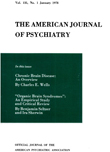COMBINED CORAMINE-ELECTROSHOCK THERAPY IN THE TREATMENT OF PSYCHOTIC EXCITEMENT
Abstract
1. The technique of administering 5 c. c. coramine, intravenously, followed by electrically induced convulsions is reported in 100 consecutive cases.
2. The method has proved of value in reducing manic excitement quickly and dramatically with as few as one or two treatments, in contrast to the necessity for repeated electroshock treatments of orthodox type in the usual manic patient.
3. The method has also proved of value in acute confusional excitement, excitement with severe agitated melancholia, paranoid excitement, excitement with schizo-affective states, and in selected cases of intractable severe anxiety.
4. It is assumed that the theoretical basis of this combined therapeutic method is as follows: Coramine, an analeptic drug, excites the higher levels of the nervous system chemically; the electroshock stimulus excites these structures electrically. The simultaneous application of both these stimuli produces an excessive, or ultramaximal, stimulus as defined by Pavlov, and the result is the ultraparadoxical state of cortical inhibition, with consequent abolition of the clinical symptom of excitement.
5. The method has been of value in handling excited patients on an open psychiatric ward in a general hospital, and in terminating these illnesses more rapidly.
Access content
To read the fulltext, please use one of the options below to sign in or purchase access.- Personal login
- Institutional Login
- Sign in via OpenAthens
- Register for access
-
Please login/register if you wish to pair your device and check access availability.
Not a subscriber?
PsychiatryOnline subscription options offer access to the DSM-5 library, books, journals, CME, and patient resources. This all-in-one virtual library provides psychiatrists and mental health professionals with key resources for diagnosis, treatment, research, and professional development.
Need more help? PsychiatryOnline Customer Service may be reached by emailing [email protected] or by calling 800-368-5777 (in the U.S.) or 703-907-7322 (outside the U.S.).



